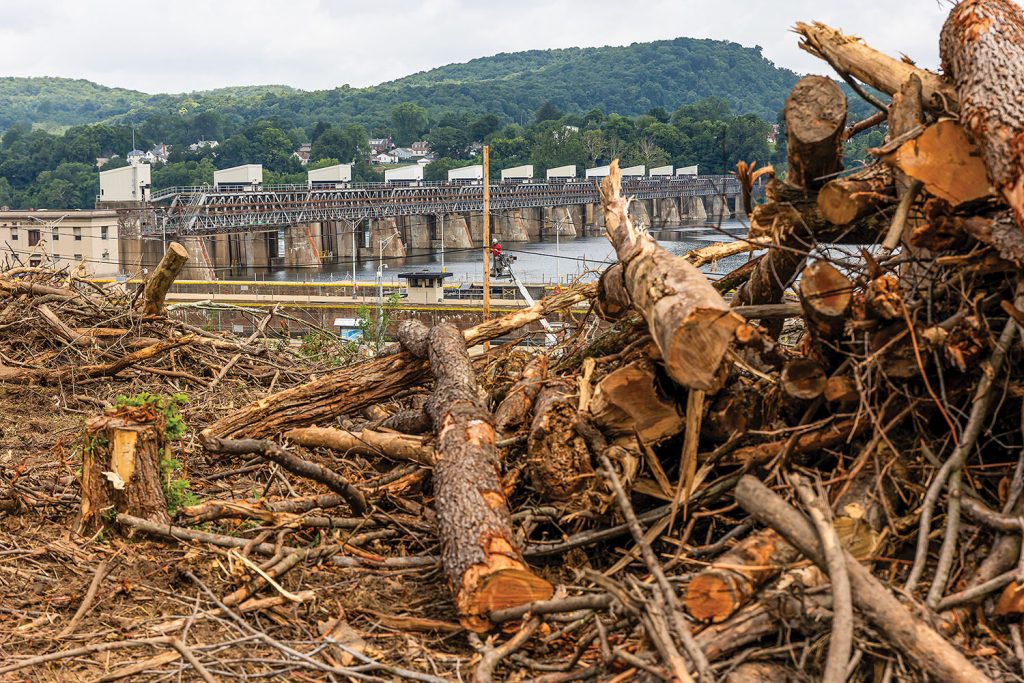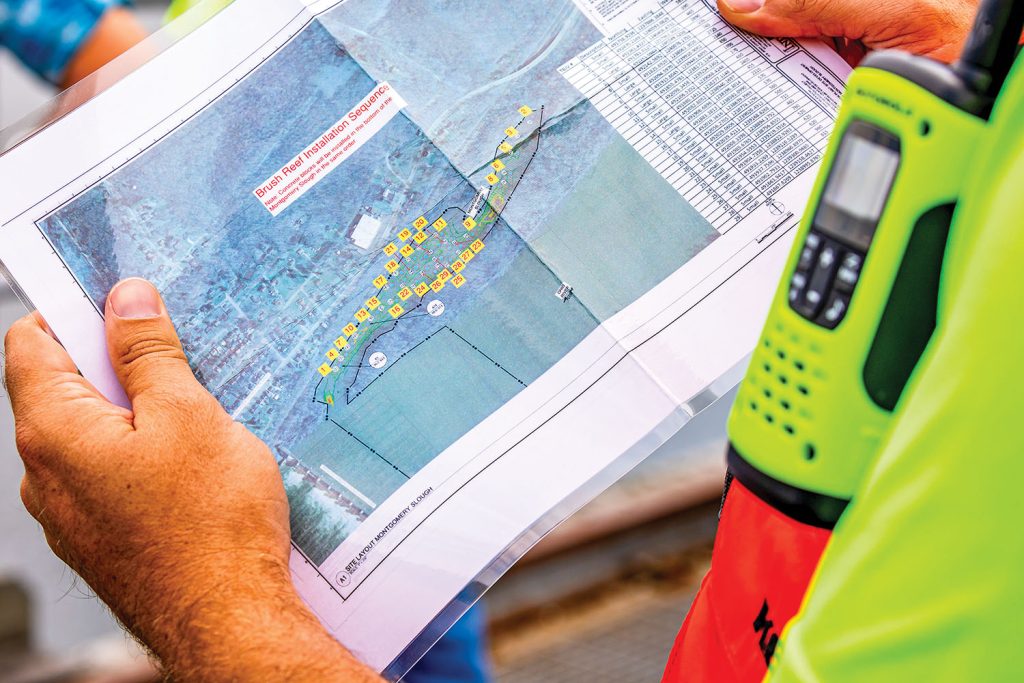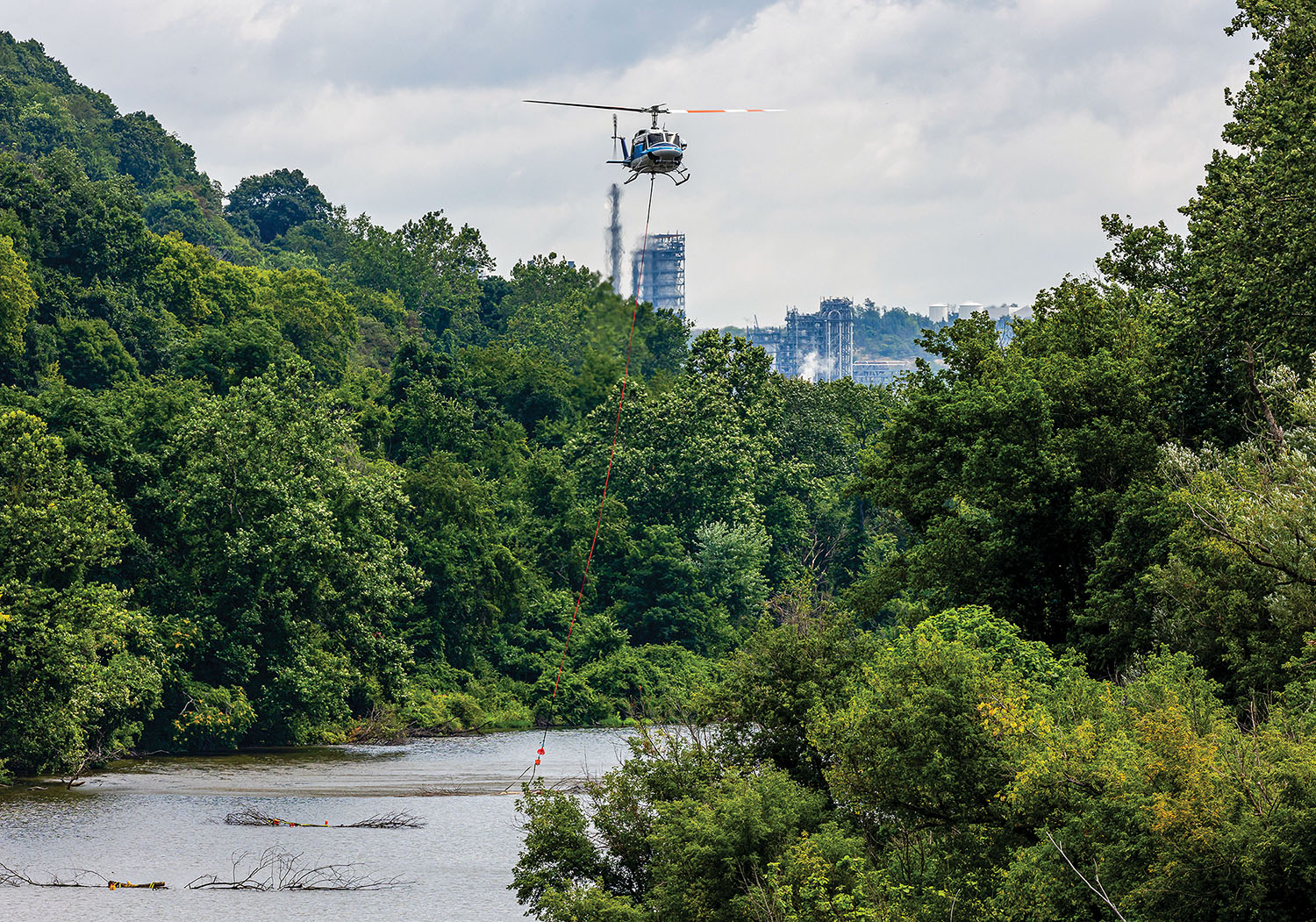Lashed together with steel cables, bundles of trees dangled from a helicopter over the upper Ohio River, ready to become fish habitats.
Twenty-nine tree bundles, removed in March from the location where the batch concrete plant is being built for construction work at Montgomery Locks and Dam, were placed into a slough 32 miles downriver from Pittsburgh on August 8.
“Seeing a helicopter flying back and forth with a bunch of trees dangling from beneath it is something you don’t see in Pennsylvania every day,” said Matt Rother, chief of the Civil Design Section for the Pittsburgh Engineer District.
The Corps coordinated the locations and spacing of the new fish habitats with the Pennsylvania Fish and Boat Commission and the U.S. Fish and Wildlife Service.
Boat crews carefully tied concrete anchors to each bundle, securing it into place. Each bundle weighs between 500 and 2,800 pounds.
The brush reefs are considered large, woody debris and function similarly to shoreline trees that fall into the river, according to Rother and Kyle Kraynak, natural resources specialist.
“The brush reefs and their dense clusters of branches and limbs provide cover and sanctuary for juvenile fish from larger fish, foraging areas for larger fish and habitats for aquatic insects,” Rother said. “The Ohio River has numerous species in it that will likely use these habitats throughout their life cycles. Some of the fish species we considered when we developed and evaluated our mitigation plan included game species such as smallmouth bass, walleye and channel and flathead catfish, as well as smaller species such as shad and shiners. The brush reefs also serve as habitats for aquatic insects such as dragonflies and may also function as perches for turtles, birds and other wildlife.”

The idea behind placing the tree bundles was two-fold: to pre-emptively provide additional habitat for fish in advance of anticipated disruption due to construction and also to beneficially reuse trees removed to allow construction.
The Pittsburgh District plans to replace the auxiliary chambers at the Montgomery, Dashields and Emsworth locks and dams with larger navigation chambers as part of the Upper Ohio Navigation Project.
“This was a fully custom-made and unique project,” Rother said. “We had to use our engineering judgment throughout. There’s not a manual out there to show us how to do this.”
The district’s planning team conducted a study to determine construction’s impact on fish habitats. The study showed the noise and turbidity in the water and sediment would disrupt fish living near the locks. The new habitat will mitigate the construction impact for all three locks in advance.
“We install mitigation methods before any potential loss occurs to the environment,” Rother said.
Completing the mitigation project first gives nature the ability to adapt to the new benefit in advance rather than try to recover after the impact is done, he said.
“Any time we construct a project, there’s an impact on the environment,” said Bobbi Jo McClain, the chief of the Environmental and Cultural Resources Section for the Pittsburgh District.
The habitat in the slough benefits fish, not only at Montgomery but all the fish that will be disturbed eventually by construction at Dashields and Emsworth as well, she said.
“We looked at a lot of different options,” McClain said. “The slough offers a unique habitat in the Ohio River throughout this region. It provided a unique opportunity to benefit fish, reusing materials that we sourced on site.”
The trees came from a plot of land uphill from the Montgomery Locks. The Pittsburgh District cleared 3.4 acres of land earlier this year. The Corps will use the space to build a concrete batch plant to produce large quantities of concrete for construction at Montgomery.
The trees were cut in March to avoid disturbing the nesting of endangered northern long-eared bats, but they were not placed until August so that they did not affect the fish spawning season, which ends in July.
The project was so successful that the district plans similar placements to replace fish habitat being lost on the lower Monongahela River as part of the Lower Mon Construction Project. The Lower Mon project involves replacing the fixed-crest dam at Locks and Dam 2 at Braddock with a gated dam, removing Locks and Dam 3 at Elizabeth and constructing a new, larger lock at Locks and Dam 4 at Charleroi.
“We plan to install fish reefs in the Monongahela River to mitigate habitat loss resulting from the removal of Lock and Dam 3 in Elizabeth, Pa., which is part of our Lower Mon project,” Rother said. “Like the effort at Montgomery Locks and Dam, the fish reefs are planned to be installed beforehand to mitigate potential impacts to the local environment.”

The district plans to install 73 fish reefs constructed from concrete rubble in the lower Monongahela River.
Jenna Cunningham, the resident engineer for the Montgomery construction project, said using the trees as fish reefs, rather than wasting them or shredding them into mulch or woodchips, was a new way of thinking for the team.
“We are building something new while preserving materials we already had here,” she said. “It’s good for us.”
Rother and Kraynak said the Pittsburgh Engineer District will take recurring inventories of the brush reefs within the slough to assess how they are holding up and if any replacements are needed while construction on the Upper Ohio Navigation Project continues.
“A team of natural resource specialists and fishery biologists will monitor these habitat structures and document their condition in the slough,” Rother said. “If the brush reefs deteriorate and no longer function as fish habitats, they will be replaced. The district considers the project successful if the brush reefs remain intact and function as fish habitats for the duration of the construction work.”
Michel Sauret, public affairs specialist for the Pittsburgh Engineer District, contributed to this report.
Caption for photo (click on photo for full image): The Pittsburgh Engineer District placed bundles of trees—cut down to make way for a concrete batch plant at Montgomery Locks and Dam—into a slough in the Upper Ohio River in August as part of a unique program designed to prevent fish habitat loss from construction of new lock chambers. (Photo by Michel Sauret/Pittsburgh Engineer District)




